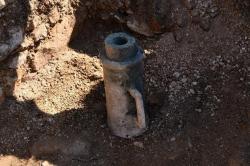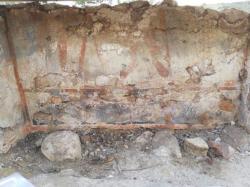ONLINE COURSES / COURS A DISTANCE
WINTER TERM : APRIL 2020
REGISTER NOW
CROATIE –  Nečven –During conservation works on the Nečven medieval fortress in Krka National Park in March, archaeologists were exalted by a valuable finding of a powerful artillery weapon – the mačkula. The extraordinarily conserved bronze specimen, the precursor of today's mortar, was used to invade fortified settlements and enemies in deep cover. Mačkula (mortar, merzer) is a weapon that holds a special place in the Croatian warrior heritage. Built at the beginning of the 14th century, the Nečven fortress is one of the most valuable monuments of medieval fortification architecture in Dalmatia.
Nečven –During conservation works on the Nečven medieval fortress in Krka National Park in March, archaeologists were exalted by a valuable finding of a powerful artillery weapon – the mačkula. The extraordinarily conserved bronze specimen, the precursor of today's mortar, was used to invade fortified settlements and enemies in deep cover. Mačkula (mortar, merzer) is a weapon that holds a special place in the Croatian warrior heritage. Built at the beginning of the 14th century, the Nečven fortress is one of the most valuable monuments of medieval fortification architecture in Dalmatia.
https://www.total-croatia-news.com/made-in-croatia/42906-archaeological-krka
NORVEGE –  Lendbreen - Climate change is leading to the retreat of mountain glaciers.In Norway, hundreds of rare archaeological finds have been revealed by melting ice in a lost mountain pass at Lendbreen in Innlandet County. The finds tell a remarkable story of high-altitude travel in the Roman Iron Age and the Viking Age.“A lost mountain pass melting out of the ice is a dream discovery for us glacial archaeologists,” says Lars Pilo, first author of the study and co-director for the Glacier Archaeology Program. “In such passes, travellers lost many artefacts that became frozen in time by the ice. These incredibly well-preserved artefacts of organic materials have great historical value.”
Lendbreen - Climate change is leading to the retreat of mountain glaciers.In Norway, hundreds of rare archaeological finds have been revealed by melting ice in a lost mountain pass at Lendbreen in Innlandet County. The finds tell a remarkable story of high-altitude travel in the Roman Iron Age and the Viking Age.“A lost mountain pass melting out of the ice is a dream discovery for us glacial archaeologists,” says Lars Pilo, first author of the study and co-director for the Glacier Archaeology Program. “In such passes, travellers lost many artefacts that became frozen in time by the ice. These incredibly well-preserved artefacts of organic materials have great historical value.”
https://www.heritagedaily.com/2020/04/melting-ice-reveals-lost-viking-mountain-pass/127604
ESPAGNE – 
 L'Espugla de Francoli - A l’occasion d’une crue en octobre 2019, des savants ont pu pénétrer jusqu’au fond du Font Major. Ils ont trouvé là des parois couvertes d’une centaine de dessins. Il y en a de deux types, comme le précise l’ «Archeology News Network». A côté de signes abstraits ou symboliques se trouvent les représentations attendues de biches, de chevaux ou de bœufs. Selon les premières conclusions de l’équipe menée par Josep Maria Vergès, les œuvres ont été tracées sur un temps long. La partie la plus ancienne remonterait au Magdalénien, la dernière phase du Paléolithique. Les peintures gravées auraient donc quinze mille ans. Les plus récentes dateraient en revanche du Néolithique,
L'Espugla de Francoli - A l’occasion d’une crue en octobre 2019, des savants ont pu pénétrer jusqu’au fond du Font Major. Ils ont trouvé là des parois couvertes d’une centaine de dessins. Il y en a de deux types, comme le précise l’ «Archeology News Network». A côté de signes abstraits ou symboliques se trouvent les représentations attendues de biches, de chevaux ou de bœufs. Selon les premières conclusions de l’équipe menée par Josep Maria Vergès, les œuvres ont été tracées sur un temps long. La partie la plus ancienne remonterait au Magdalénien, la dernière phase du Paléolithique. Les peintures gravées auraient donc quinze mille ans. Les plus récentes dateraient en revanche du Néolithique,
https://www.bilan.ch/opinions/etienne-dumont/une-grotte-prehistorique-couverte-de-fresques-a-ete-decouverte-en-catalogne
ARCHEOLOGIE - Une équipe de chercheurs britanniques a mis au point une nouvelle méthode de datation des poteries permettant aux archéologues de dater avec une précision remarquable les découvertes préhistoriques du monde entier. Grâce à cette méthode révolutionnaire mise au point par des scientifiques de l’université de Bristol, récemment présentée dans la revue Nature, il est désormais possible de dater ces objets directement, à partir des acides gras laissés par la préparation des aliments qu’ils contenaient. La méthode consiste à isoler les différents composés gras des résidus alimentaires, laissés par exemple par la cuisson de la viande ou du lait, et tout en s’assurant qu’ils soient suffisamment purs pour une datation précise en utilisant les dernières technologies de spectroscopie par résonance magnétique nucléaire à haute résolution et de spectrométrie de masse. Afin de s’assurer que le procédé offre une estimation aussi précise que d’autres matériaux couramment utilisés en archéologie, comme les os, les graines ou le bois, l’équipe a ensuite examiné des échantillons de graisse de poteries anciennes pour une série de sites célèbres en Grande-Bretagne, en Europe et en Afrique, vieux de 8 000 ans. Quel que soit le site archéologique analysé, cette nouvelle méthode de datation s’est révélée d’une précision incroyable.
https://dailygeekshow.com/methode-datation-poteries/
BULGARIE – 
 Cherven - A fourteenth-century Christian church decorated with murals has been discovered in northeastern Bulgaria’s medieval city of Cherven. The church is the sixteenth to be uncovered in the Cherven Archaeological Preserve. Fragments of the frescoes include images of painted drapery and a scene depicting “warrior saints.” Some of the murals have been transferred to a conservation laboratory, where they will be restored and placed on a reinforced surface for display at the Ruse Regional Museum of History. In the area around the church, the excavation team has uncovered a cemetery, a medieval street, and other buildings. The city was conquered and ransacked by the Ottomans in A.D. 1388.
Cherven - A fourteenth-century Christian church decorated with murals has been discovered in northeastern Bulgaria’s medieval city of Cherven. The church is the sixteenth to be uncovered in the Cherven Archaeological Preserve. Fragments of the frescoes include images of painted drapery and a scene depicting “warrior saints.” Some of the murals have been transferred to a conservation laboratory, where they will be restored and placed on a reinforced surface for display at the Ruse Regional Museum of History. In the area around the church, the excavation team has uncovered a cemetery, a medieval street, and other buildings. The city was conquered and ransacked by the Ottomans in A.D. 1388.
http://archaeologyinbulgaria.com/2020/04/02/14th-century-murals-with-warrior-saints-found-in-newly-discovered-church-in-medieval-city-cherven-in-northeast-bulgaria/
CAMBODGE -  Angkor - ANA director of Exploration and Research Projects, Srun Tech, said on Wednesday that the 21 Buddha statues and 141 fragments were buried about half a meter deep at the Angkor Wat Temple area.“This accidental discovery happened April 11. What we found were mostly Buddha statues, some of which had broken heads, arms, legs and other pieces. These statues are of Buddha sitting as well as standing.“There is soil, mixed with modern remnants, meaning that they were probably buried in the 1960s or 1970s because we found fragments of a bicycle bell, a plastic bag and other materials. These statues were not buried in ancient times,” he said. The deputy director at Angkor International Research and Documentation Centre, Im Sokrithy, said the statues were buried in the same pit, and were of different sizes.
Angkor - ANA director of Exploration and Research Projects, Srun Tech, said on Wednesday that the 21 Buddha statues and 141 fragments were buried about half a meter deep at the Angkor Wat Temple area.“This accidental discovery happened April 11. What we found were mostly Buddha statues, some of which had broken heads, arms, legs and other pieces. These statues are of Buddha sitting as well as standing.“There is soil, mixed with modern remnants, meaning that they were probably buried in the 1960s or 1970s because we found fragments of a bicycle bell, a plastic bag and other materials. These statues were not buried in ancient times,” he said. The deputy director at Angkor International Research and Documentation Centre, Im Sokrithy, said the statues were buried in the same pit, and were of different sizes.
https://www.phnompenhpost.com/national/angkor-buddhas-unearthed